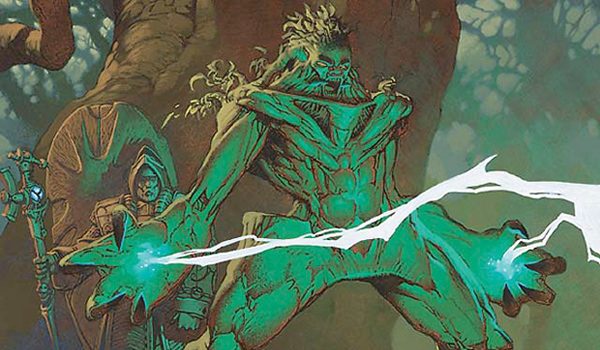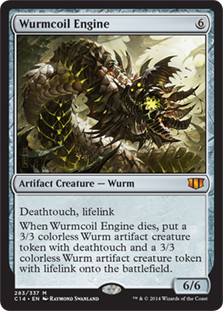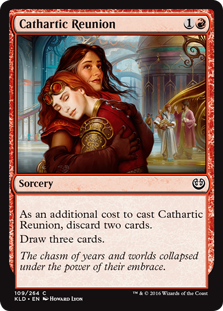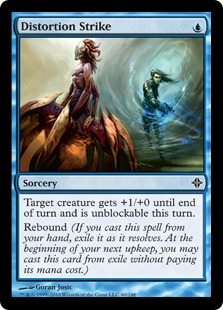Are you a Quiet Speculation member?
If not, now is a perfect time to join up! Our powerful tools, breaking-news analysis, and exclusive Discord channel will make sure you stay up to date and ahead of the curve.
Recently, there’s been a lot going on in the world "non Magic-wise." The Cubs finally overcame the hundred-year curse, South Korea got really weird, and America proved that polling actually is absolutely worthless. If you’ve been too busy staring at supermoons and lamenting the end of society as we know it, fret no more. Everything really will be okay. Tomorrow, the sun will rise all the same.

Today, we’ll be using the last two major Modern events, Grand Prix Dallas/Fort Worth and the Star City Games Modern Open in Columbus, to give an overview of this "new Modern" we find ourselves in. Don’t think we’re in a "new Modern?" Think the last two weeks were just business as usual? Well, we’ll see, won’t we?
[wp_ad_camp_1]
Who’s on Top?
If we’re looking purely at the final table results from Dallas and Columbus, it would seem the top players in the format are Skred Red, Grixis Control, GW Tron, and Dredge. Now, clearly we know that this misses the mark completely for three out of four, but regardless, these results should make us question our assumptions about the format. If we really think that Infect, Affinity, and Jund are the pillars of Modern, why aren’t they showing up at the final table?
 Now, obviously this is an over-simplification of game-day metagames, which affect weekend results much more potently than any conjecture gifted authors can pontificate about during the weekday. It doesn’t matter if every Magic writer touts up Death's Shadow Zoo as the most powerful deck in the format if nobody plays it, or more accurately, people listen and adjust accordingly to not get beaten by it. The narrative, just as much as physical, tangible results, can sway virtual power among the Axis and Allies of Modern.
Now, obviously this is an over-simplification of game-day metagames, which affect weekend results much more potently than any conjecture gifted authors can pontificate about during the weekday. It doesn’t matter if every Magic writer touts up Death's Shadow Zoo as the most powerful deck in the format if nobody plays it, or more accurately, people listen and adjust accordingly to not get beaten by it. The narrative, just as much as physical, tangible results, can sway virtual power among the Axis and Allies of Modern.
As every form of analysis must entertain speculation at some point, it’s possible we could just "be wrong." With that in mind, perhaps we need to constantly measure new information against prior perceptions, to stress-test our conclusions to prove their validity. If Infect isn’t putting up results, perhaps it isn’t the powerhouse we thought it was? If Grixis Control can’t manage a Top 16 for months, perhaps I should have given it up a long time ago? Looking at Dallas in hindsight, where Grixis Control took second place out of nowhere, an argument can at least be made that we should take results that go against the narrative we’ve created with a grain of salt. Maybe Infect still is the top deck, and it just had a bad week. Maybe Affinity isn’t being hated out of the metagame, but instead the format has just shifted to a point where it is no longer enjoying the favorable conditions it once was.
So, in an attempt to recalibrate our understanding of the format, let’s look at some archetype case studies from the top tables of the past two events. First up, Dredge.
Dredge, by Matt Ayers (2nd, SCG Columbus Open)
Cathartic Reunion has, at this point, become universally adopted in Dredge lists, for good reason. A strict upgrage to Tormenting Voice, Cathartic Reunion can ditch a dredge spell and a Bloodghast from our opener at once, while simultaneously drawing/dredging us three times. Or, better yet, ditch a dredge spell (or two) and watch your graveyard fill up as you dredge into more dredge abilities for each of your three draws. With 8 five-plus dredge spells in our deck (Stinkweed Imp and Golgari Grave-Troll), we’re hitting pay dirt often.
 What Dredge does is nothing new, but Cathartic Reunion along with a whole lot of grinding and list optimization has resulted in a lean, tuned machine that is primed to wreak havoc upon an unprepared format. All the midrange value in the world won’t save you from Dredge’s machine, as Jund has learned. Without Scavenging Ooze, Anger of the Gods, or sideboard bombs, Jund (and reactive decks like it) are left scrambling for something to stop the value train.
What Dredge does is nothing new, but Cathartic Reunion along with a whole lot of grinding and list optimization has resulted in a lean, tuned machine that is primed to wreak havoc upon an unprepared format. All the midrange value in the world won’t save you from Dredge’s machine, as Jund has learned. Without Scavenging Ooze, Anger of the Gods, or sideboard bombs, Jund (and reactive decks like it) are left scrambling for something to stop the value train.
While not new by any sense, Insolent Neonate, another one-drop (in addition to Faithless Looting) that can start us dredging as early as turn two, has greatly increased the velocity of the archetype compared to pre-Neonate versions. With Carthartic Reunion and Insolent Neonate as additions, contemporary Dredge is much faster, more powerful, and more consistent than prior versions that saw Golgari Grave-Troll get banned in the first place.
Now, I’m not arguing for a Dredge banning, as it has proven to be just as susceptible to hate in the format as Affinity. The tools to beat Dredge are widespread and accessible, and while the archetype is powerful, and the games it wins can sometimes seem one-sided, it is by no means warping the format with its presence. Sure, we’re seeing an uptick in Kalitas, Traitor of Ghet and Scavenging Ooze as a response to Dredge’s increasing market share in the format, but we’re nowhere near Splinter Twin and Eldrazi levels of representation. For now, Dredge is a powerful, capable, visible monster under the bed. We know it's there, and we have the magical baseball bat. Yes, that might possibly be a relic of my childhood still lingering in the cavities of my subconscious. Next…
Infect, by Mike Mei (3rd, GP Dallas)
We’ve talked about Infect at length in recent articles, so I’ll try not to restate my thoughts on the deck here as well. Still, for reference, Infect exists as the fastest, most consistent, most resilient linear aggressive deck in the format, especially in post-board games. Sure, Affinity is faster and more consistent, as Infect still struggles with the 12-creature issue, but Affinity’s 80% game one winrate plummets once opponents gain access to ever-present artifact hate cards in their sideboard. Infect, in many matchups, gets even better after board, as it gains tools to fight specific matchups in place of general mainboard stinkers like Dismember or Rancor.
 Speaking of Rancor, I’m glad to see Mike specifically moving away from Distortion Strike, while not leaving himself completely dead to Lingering Souls and the like. Distortion Strike has always been pretty underwhelming for its mana cost (considering we’re often spending G for +4/+4 or +6/+6) and while Rancor isn’t much better, we still get some extra oomph out of it past the initial investment. With Blossoming Defense replacing Apostle's Blessing, and now Rancor seeing play over Distortion Strike, we’re reaching a flash point where Infect has finally assembled a critical mass of protection and pump to do whatever it pleases game after game. I’ll say it here definitively: if it wasn’t for the 12-creature issue lending the archetype some inconsistency, we would be seeing Infect representation at pre-banning Eldrazi levels sweeping the format.
Speaking of Rancor, I’m glad to see Mike specifically moving away from Distortion Strike, while not leaving himself completely dead to Lingering Souls and the like. Distortion Strike has always been pretty underwhelming for its mana cost (considering we’re often spending G for +4/+4 or +6/+6) and while Rancor isn’t much better, we still get some extra oomph out of it past the initial investment. With Blossoming Defense replacing Apostle's Blessing, and now Rancor seeing play over Distortion Strike, we’re reaching a flash point where Infect has finally assembled a critical mass of protection and pump to do whatever it pleases game after game. I’ll say it here definitively: if it wasn’t for the 12-creature issue lending the archetype some inconsistency, we would be seeing Infect representation at pre-banning Eldrazi levels sweeping the format.
If that’s the case, shouldn’t Infect be leading the format? We saw it perform relatively well at GP Dallas, taking 3rd, 6th, 8th and 10th place, so Dallas’s results at least fit the narrative that Infect is a top deck in Modern. Columbus, on the other hand, has Infect missing the Top 16 completely, with the archetype only able to muster up top performances of 21st, 22nd, and 24th place. At this point, we’ve reached speculation territory. Is Infect a great deck that is performing inconsistently, or is folding to dedicated hate? Or is it a poor deck, capable of powerful things à la Affinity, that finds itself in a format where every matchup is an uphill battle?
Bant Eldrazi, by Adam Fronsee (6th, SCG Columbus Open)
The last deck I want to discuss, Bant Eldrazi, is my third contender for top deck in the format. Ajani, Mentor of Heroes aside, Bant Eldrazi has been tuned to the point of perfection for weeks now, and we’ve seen relatively the same list put up consistent results week after week for what seems like forever at this point. Ancient Stirrings, Path to Exile, Noble Hierarch—Bant Eldrazi takes the most powerful spells in its colors and combines them with a synergistic engine that borders on unfair. With a powerful, fast, consistent maindeck and a potent list of sideboard options, Bant Eldrazi exists as one of the most powerful decks in the format without a glaring weakness to hold it back.
So, why isn’t it winning more? Again, we can only speculate from here, but I’m of the opinion that the format is just not of the right conditions for Bant Eldrazi to dominate. Tron is diminished but still present, and the rest of the format is just fast enough to make powerful, grindy beaters like Drowner of Hope and Reality Smasher awkward. The decks Bant Eldrazi is built to prey on (Jund Midrange, Jeskai Control, the mirror) are just not seeing play in large numbers, and currently Eldrazi is getting by against an unfavorable format purely on power and consistency.
Conclusion
Long-present format mainstays like Burn and Affinity have diminished in recent months, replaced instead by Dredge and Infect. Midrange archetypes like Jund and Junk have for the most part disappeared, though they still put up occasional numbers due more to their lack of weaknesses than any particular strength or unique technology. Bant Eldrazi is an ever-present force in the format that is simultaneously keeping its best matchups at bay while at the same time is held in check by the hyper-aggressive environment it has helped foster. The resulting context is a tenuous one—any archetype can perform well on any given weekend, as seen by top performances from rogue archetypes like Grixis Control, Skred Red and GW Tron. What deck will be on top next week? Your guess is as good as mine.
Thanks for reading,
Trevor Holmes
The_Architect on MTGO
Twitch.tv/Architect_Gaming
Twitter.com/7he4rchitect




Ooh I can smell it. Can you?
Bloodbraid unbanning 😛
Great article once again. Thanks!
BBE is not going to be unbanned…what is with Jund players and their BBEs?
Glad to hear I’m not the only one finding the metagame a lot less predictable lately. Really makes me want to see the numbers for October ASAP.
Excelente articulo ! que buen deck bant eldrazi, muy versatil. es verdad que va un turno atras del metagame pero de igual manera se levanta.
This is what a healthy format is. Anyone deck can win!
Dredge, Burn and Affinity are big three everpresent now
If you see absence of any -> people will pack less hate -> archetype is good